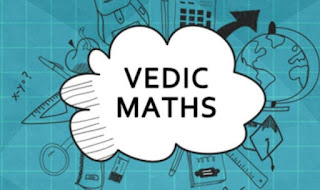VEDIC MATHS-44
VEDIC MATHS
By OMKAR TENDOLKAR
This is post number 44 from the series of "Vedic maths" blogs. Here in this blog we will learn about "Base Method of Division part-1"
The base method of division is having large contribution in Vedic Mathematics. The name Base method is given by Vedic Mathematics in western countries.
The study of division is divided in two parts. In this post we will study the Base Method and in the next blogs we will study the Paravartya Method of division.
We have seen the applications of the Base Method in multiplication and squaring of numbers in previous blogs. In this method we use power of ten as a base and then calculate the difference between the base and the given number. The same concept will be used for division.
FORMAT
The style of presentation used in this system is very much unlike the traditional system. Have a look at the diagram below:
Base
Dividend
We will divide the dividend in two parts. The RHS will contain as many digits as the number of zeros in the base. The final answer obtained on the LHS is the quotient and RHS is the remainder.
Examples:
1.Divide 23 by 9
Here we have to divide 23 by 9. The divisor is 9, the base is 10 and the difference is 1.
STEP 1:
Next, since the base 10 has one zero in it, we divide the dividend in such a way that the RHS has one digit.
We now bring down the first digit of the dividend, viz. 2, as shown in the diagram below:
10
10
The product of 2 and 1 (the difference) is 2 which is written below 3. The sum of 3 and 2 is 5.Thus, when 23 is divided by 2 the quotient is 2 and the remainder is 5.
2. Divide 31 by 9
The divisor is 9, the base is 10 and the difference is 1. We divide the dividend in two parts with one digit in the RHS as there is one zero in the base.
10
We write down the first digit of the dividend 3 as shown above
10
Next, we multiply the 3 written down with the difference 1. The product so obtained is written below the second digit of the dividend. Finally, we add the digits 1 and 3 to get the answer 4.
10
- In this case the dividend is 31 and the divisor is 8. We divide 31 into two parts with the right hand side having as many digits as the number of zeros in the base. Since, the base ten has one zero we have one digit in the RHS of the dividend.
- We write the divisor as 8 and the difference below it as 2.
- We bring down the first digit of the dividend 3 as it is.
- We multiply the 3 with the difference 2 and get the product 6. This is written down below the second digit of the dividend, viz. 1. The total is 7. Hence, the quotient is 3 and the remainder is 7.
- 23 / 8, then quotient is 2 and remainder is 7.
- 24 / 8, then quotient is 3 and remainder is 0.
- 42 / 8, then quotient is 5 and remainder is 2.
1. 46 / 8
2. 38 / 9
3. 40 / 7
You may answer this in comment box. You may ask your any query or doubt in comment box. I will try to resolve as early as possible.
In next blog we will discuss about "Example of Base Method of Division part-2".
We will meet very soon through our next blog. Till that stay connected, stay healthy and stay safe.
Thanks
for giving your valuable time.
Good day😊.


Comments
Post a Comment